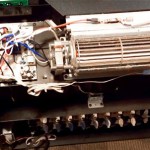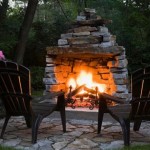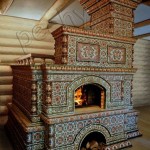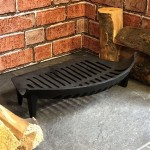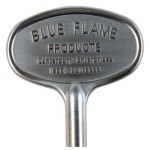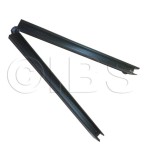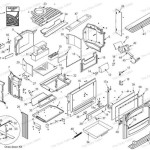Gas Fireplace Insert Clearance To Combustibles: A Comprehensive Guide
Gas fireplace inserts provide an efficient and aesthetically pleasing way to heat a home. They offer the ambiance of a traditional fireplace while boasting improved energy efficiency and ease of use. However, the safe installation of a gas fireplace insert is paramount. Adhering to proper clearance requirements from combustible materials is not merely a suggestion but a code requirement vital for preventing fires and ensuring the safety of the occupants.
Clearance to combustibles refers to the minimum distance required between the gas fireplace insert and any materials that can ignite or burn, such as wood, drywall, fabrics, and furniture. These clearances are carefully determined by manufacturers and regulatory bodies through rigorous testing and are outlined in the insert's installation manual and relevant building codes. Deviating from these stipulated distances can significantly increase the risk of a fire, potentially leading to property damage, injuries, or fatalities.
This article will delve into the critical aspects of gas fireplace insert clearance to combustibles, examining the factors influencing these clearances, the potential hazards of non-compliance, and the best practices for safe installation.
Understanding Combustible Materials
The term "combustible" encompasses a wide range of materials commonly found in and around homes. These materials have the potential to ignite and sustain a fire when exposed to sufficient heat. Understanding which materials are classified as combustible is the first step in ensuring safe installation practices.
Common combustible materials include, but are not limited to:
*Wood:
Framing lumber, trim, paneling, and furniture are all highly combustible and require careful consideration. *Drywall:
While drywall itself has some fire-resistant properties, the paper facing is combustible. *Fabrics:
Drapes, curtains, upholstery, rugs, and other textiles readily ignite and spread flames quickly. *Paper Products:
Wallpaper, books, and other paper-based items are easily ignited and can contribute to the rapid spread of a fire. *Plastics:
Many plastics, including vinyl siding and certain types of insulation, are combustible and can release toxic fumes when burned. *Building Insulation:
Many types of insulation, especially fiberglass and cellulose, are considered combustible.It is essential to consult the specific installation manual for the gas fireplace insert, as it will provide detailed information on which materials are considered combustible in relation to that particular model. The manual will also specify the exact clearance requirements for each side, the top, and the rear of the unit.
Factors Influencing Clearance Requirements
The required clearance to combustibles varies depending on several factors related to the gas fireplace insert and the surrounding environment. These factors are carefully considered during the design and testing phases to ensure safe operation.
*Insert Model and Design:
Each gas fireplace insert model has unique heating characteristics and ventilation systems. The design of the firebox, the type of burner, and the efficiency of the heat exchanger all influence the surface temperatures of the insert and the surrounding area. Manufacturers conduct extensive testing to determine the minimum clearances necessary to prevent overheating of combustible materials. Therefore, adhering strictly to the manufacturer's specifications is crucial. *BTU Input Rating:
The British Thermal Unit (BTU) input rating indicates the amount of heat the insert is capable of producing. Inserts with higher BTU ratings generate more heat and generally require greater clearances to combustibles. A higher BTU output means the surfaces of the insert will become hotter, thus needing more distance from combustible materials to prevent ignition. *Venting System:
The type of venting system used can affect the surface temperatures of the insert and the surrounding area. Direct vent systems, for example, draw combustion air from outside the home and vent exhaust gases directly outdoors, which can help reduce surface temperatures compared to natural vent systems. The manufacturer's instructions for the venting system must be followed precisely to ensure proper heat dissipation. *Wall Construction:
The composition of the surrounding walls also plays a role in determining clearance requirements. Walls constructed of non-combustible materials, such as concrete or brick, may allow for reduced clearances compared to walls with wood framing and drywall. However, it is important to verify that the non-combustible material is continuous and extends beyond the area of potential heat exposure. The presence of combustible materials behind non-combustible surfaces, such as wood studs behind brick, must also be considered. *Presence of a Mantel:
The presence of a mantel above the fireplace insert can also influence clearance requirements. Mantels are typically constructed of wood or other combustible materials and can trap heat, potentially leading to overheating. The height and depth of the mantel will affect the required clearance, as a deeper mantel will trap more heat. The manufacturer's instructions usually provide specific guidance on mantel clearances.Consequences of Ignoring Clearance Requirements
Failing to adhere to the specified clearance requirements for a gas fireplace insert can have severe consequences, ranging from minor inconveniences to catastrophic events.
*Fire Hazard:
The most significant risk associated with ignoring clearance requirements is the potential for a fire. When combustible materials are placed too close to a heat source, they can gradually dry out and become more susceptible to ignition. Over time, the constant exposure to elevated temperatures can lower the ignition point of the material, eventually leading to a fire. Even if a fire does not immediately break out, the prolonged exposure to heat can cause charring and degradation of the combustible material, compromising its structural integrity. *Voiding of Warranty:
Installing a gas fireplace insert without adhering to the manufacturer's clearance requirements will almost certainly void the warranty. This means that any repairs or replacements needed due to issues related to improper installation will not be covered. The manufacturer's warranty is based on the assumption that the insert will be installed and operated according to their specifications. *Insurance Issues:
In the event of a fire caused by improper installation, homeowners insurance may not cover the damages if the homeowner failed to comply with building codes and manufacturer's instructions. Insurance companies often investigate the cause of a fire and may deny coverage if they find evidence of negligence or non-compliance with safety regulations. *Carbon Monoxide Poisoning:
While less directly related to clearance to combustibles, improper installation, which can be associated with ignoring clearance requirements, can compromise the venting system. A faulty or improperly installed venting system can lead to the leakage of carbon monoxide, a colorless and odorless gas that is highly toxic. Carbon monoxide poisoning can cause serious health problems and even death. *Structural Damage:
Even if a fire does not occur, prolonged exposure to excessive heat can cause structural damage to the surrounding walls and framing. This damage can weaken the structure and compromise its stability. Over time, the constant heating and cooling cycles can cause wood to warp, crack, and deteriorate, leading to costly repairs.Best Practices for Safe Installation
To ensure the safe and proper installation of a gas fireplace insert, it is crucial to follow these best practices:
*Consult the Installation Manual:
The first and most important step is to thoroughly read and understand the installation manual provided by the manufacturer. The manual contains detailed information on clearance requirements, venting procedures, gas line connections, and other critical installation details. The manual is the definitive guide for installing the specific model of gas fireplace insert. *Measure Accurately:
Use a measuring tape to accurately determine the required clearances to combustibles. Pay close attention to the dimensions specified in the installation manual and ensure that all measurements are precise. Double-check all measurements before proceeding with the installation. *Maintain Specified Clearances:
Adhere strictly to the specified clearance requirements. Do not attempt to reduce clearances by modifying the insert or the surrounding structure. If you are unsure about the correct clearances, consult with a qualified installer or the manufacturer. *Use Non-Combustible Materials Where Possible:
Where possible, use non-combustible materials, such as cement board or metal, to create a barrier between the insert and combustible materials. This can help reduce the risk of fire and provide an extra layer of protection. Ensure that the non-combustible material extends beyond the area of potential heat exposure. *Check Local Building Codes:
Familiarize yourself with local building codes and regulations regarding the installation of gas fireplace inserts. These codes may have additional requirements beyond those specified in the manufacturer's installation manual. Contact your local building department for guidance. *Hire a Qualified Installer:
If you are not comfortable performing the installation yourself, hire a qualified and licensed installer to do the job. A qualified installer has the knowledge and experience to ensure that the insert is installed safely and correctly. Check the installer's credentials and references before hiring them. *Inspect Existing Chimney:
If you are using an existing chimney, have it inspected by a qualified chimney sweep to ensure that it is in good condition and can safely vent the exhaust gases. A damaged or obstructed chimney can pose a serious fire hazard and can also lead to carbon monoxide poisoning. *Install Carbon Monoxide Detectors:
Install carbon monoxide detectors in your home, especially near sleeping areas. Test the detectors regularly to ensure that they are functioning properly. Carbon monoxide detectors can provide early warning of a carbon monoxide leak, giving you time to evacuate the premises and seek medical attention. *Regular Maintenance:
Perform regular maintenance on your gas fireplace insert according to the manufacturer's recommendations. This includes cleaning the burner, inspecting the venting system, and checking for any signs of damage or wear. Regular maintenance can help prevent problems and ensure the safe and efficient operation of the insert.Addressing Common Clearance Challenges
During the installation process, homeowners and installers may encounter challenges in meeting the required clearance to combustibles. Here are some common challenges and potential solutions:
*Limited Space:
In some cases, the available space may be limited, making it difficult to maintain the specified clearances. In these situations, consider using a smaller insert model that requires less clearance. Alternatively, you may need to modify the surrounding structure to create more space. *Existing Fireplace Surround:
If you are installing the insert into an existing fireplace opening, the surround may be constructed of combustible materials. In this case, you may need to remove the existing surround and replace it with non-combustible materials. *Proximity to Furniture:
Ensure that furniture, drapes, and other combustible materials are kept at a safe distance from the insert. Rearrange the room layout if necessary to maintain the required clearances. *Mantel Clearance Issues:
If the mantel is too close to the insert, you may need to raise the mantel or install a heat shield to deflect heat away from the combustible material. Consult the manufacturer's instructions for guidance on mantel clearances and heat shield options.By understanding the importance of clearance to combustibles, the factors that influence clearance requirements, and the potential consequences of non-compliance, homeowners can ensure the safe and efficient operation of their gas fireplace inserts. Adhering to the manufacturer's instructions, consulting with qualified professionals, and following best practices for installation are essential for protecting property and lives.

Fireplace Chimney Clearances Information Canadian

Fireplace Construction

Mantel Clearance For Masonry Versus Manufactured Fireplaces

Fireplace Mantel And Surround Clearances Fine Homebuilding

Gas Fireplace Insert How To Choose For The French Country Mantel

How Fireplace Inserts Work We Love Fire

Gas Fireplace Insert How To Choose For The French Country Mantel
Wood Fireplace Insert And Required Clearances Hearth Com Forums Home

Fireplace Safety And Codes

Fireplace Insert Vs Zero Clearance Maple Mtn

